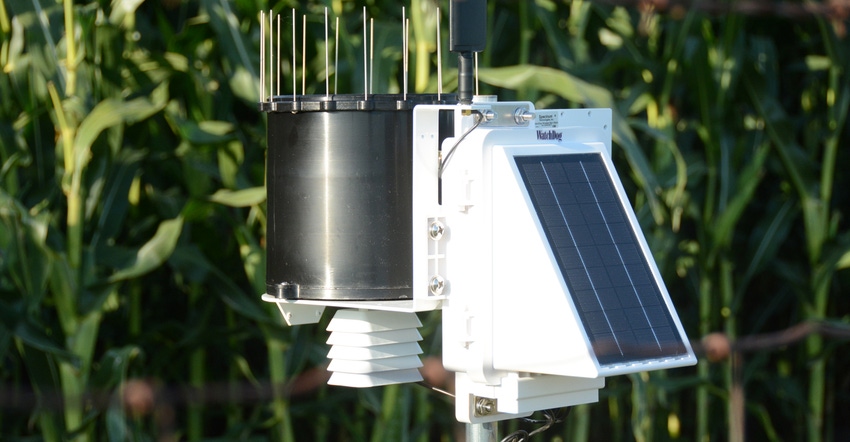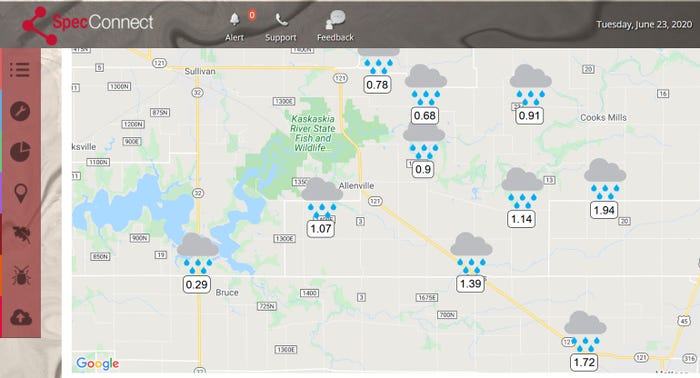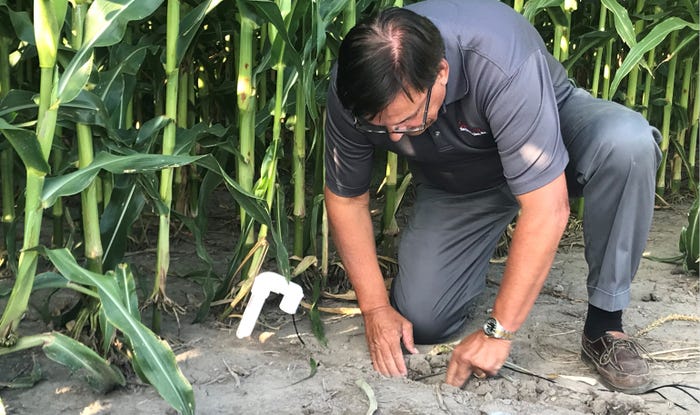
When your farm’s spread out 60 miles across, there’s one question you really need answered in the spring: How wet is it?
That’s the main reason Bill Voyles, Sullivan, Ill., signed on to test a new weather station from Spectrum Technologies last year. Voyles ran a beta test on the WatchDog 3220 Wireless (cellular) Rain Station, with an SM 100 Soil Moisture Sensor connected that gave readings for how wet the soil was following a rain event. The unit also measures temperature and relative humidity.
Related: Learn value of on-farm weather data
He put the mobile station and its soil moisture meter to the test, moving it across 40 miles to three different fields, and then moving it within fields as well — important in fields that were up to 400 acres in size. He says the learning curve was steep but worth it.
“We second-guessed it a lot at first,” Voyles says. “It was a matter of learning what the moisture number meant relative to what we knew.”

When the number looked dry, he’d go give it a visual, both to learn and to ground-truth the reading. Eventually, he learned what number correlated with what he knew about soil moisture. A soil moisture cheat sheet, as he called it, from Spectrum helped, too.
“It was neat to watch prior to planting. By sidedress time, we’d learned a lot, and it was reassuring to see those numbers were accurate and close,” Voyles says.
Voyles admits he had never paid attention to soil moisture readings before, but he was intrigued with this project. “I’m old school — go out with a handball. But I wanted to see if that would give me readings that would help with time and efficiency.”
It did, and he learned more about his soil types, too: “We learned that the variation in soil moisture was still there, no matter what the soil type was.”
This beta test wasn’t Voyles’ first rodeo with weather stations. He’s used 10 of the WatchDog Wireless Rain/Temp Stations since 2019. That’s an antenna-based system that sends data to a receiver on his grain leg, then shoots to the SpecConnect cloud for storage. It costs less, but it only has a 10- to 12-mile radius from the grain leg, and it has to be line-of-sight.
Mike Thurow, head of Spectrum Technologies, sought volunteers in 2020 to test the new weather equipment with soil moisture sensors. In addition to Bill Voyles’ station near Sullivan, John and Holly Spangler installed one in a field on their farm in west-central Illinois, near Marietta. Thurow also installed one on Ryan and Jim Facemire’s farm near Edinburgh, Ind.

Voyles says he’s 99% sure he’ll pay for and keep the model he beta-tested this year. “There’s a lot I can continue to learn from.”
He says while the unit also measures wind speed and he did occasionally look at it, he didn’t use it much. “I want more accurate per-field information. A 400-acre field can be a mile long, so there’s a big difference in that field. We carry a wind speed gauge in the sprayer,” Voyles says.
Voyles reports the WatchDog app was easy to use, even for his 72-year-old dad. “The app helped us in more ways than one, including troubleshooting some of the stations,” he says. “Even through the non-growing season, I look at it daily and pay attention to soil freezing. We’ll look at it every 10 minutes during a rain event!”
He plans to invest in one cellular unit at a time, due to cost. His goal is to get four eventually, with one on each corner of his farm.
“It is a very good tool in the toolbox,” he concludes.
Related: Soil type critical to moisture content this time of year
Learn more about these units at specmeters.com. The unit installed on both the Voyles and Spangler farms is the Watch Dog 3220 wireless remote weather station. Once on the website, click on “weather stations” on the top bar and select the Model 3000 from the dropdown menu to learn more. List price is $1,495 plus $49 setup fee. You will also need the $379 annual subscription fee for the app to relay information to your phone and to store data from the field long term. The SM 100 soil moisture meter with 20-foot cable is an additional $105. You can purchase a tripod stand for $107, or mount the weather station on your own post or stake.
About the Author(s)
You May Also Like






